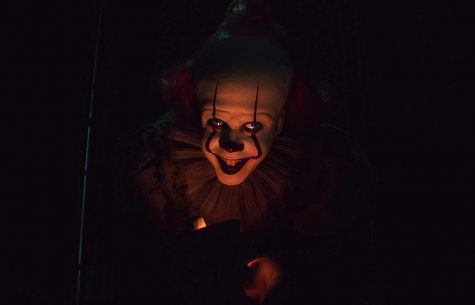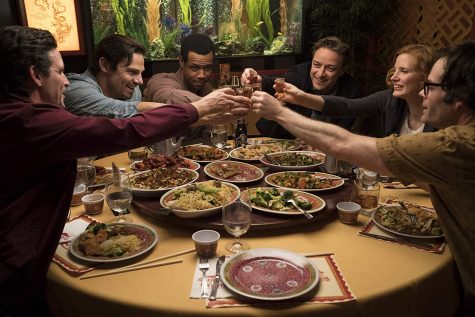It Chapter Two: A Scareless Screamfest
Sep 20, 2019
Note: This article contains spoilers for “It” (2017), “It Chapter Two” (2019), and “Inglourious Basterds” (2009).
I watched “It” (2017) at a friend’s house. Hands clawed my cheeks, ready to cover my eyes during the scary parts. “It” introduced me to horror, but the kid protagonists’ comradery and heart made it bearable. When, at the movie’s climax, the Losers’ Club struck, kicked, cornered a weakening Pennywise, their bravery transitioned to me. I was no longer scared.
Outside the theater, last weekend, a biting wind cut through my jacket as the long, twisting line I waited in funneled toward two ticket booths. The seats were almost sold out, so my friends and I ended up in row F, a little closer than usual. The screen filled my entire vision. There would be no averting my eyes from whatever horrors crept into the frame, and I was well past covering them with my hands. Before we could settle, the Warner Bros. logo flickered alight.

Pennywise reveals himself hiding beneath the bleaches. After his gloved hands snatched a firefly from the air, Pennywise opened his palms, illuminated his face, and said a friendly, “Hello.”
The creature behind the curtain…
…or in the sewer. If you saw “It,” then you’ll remember the bone-chilling first scene where Georgie Denbrough loses his arm. Nothing during “It” surpassed that pure moment of shock and gore. Yet that scene’s true terror begins the instant Pennywise slinks into the sewer.
Because you know what’s coming.
Same as in “It Chapter Two,” which contains a scene structurally identical to Georgie’s. This time a girl with a birthmark on her cheek sits beside her mother on bumpy bleacher seats, watching a local baseball game. A firefly dances into view, and the girl is off, chasing it down the bleachers … under the bleachers.
Guess who’s waiting for her.
This is one horror technique both “It” movies do well: building suspense. In these scenes, we meet two innocent and gullible children who find themselves in contact with Pennywise. In both, they are given the option to escape (Georgie says he can’t talk with strangers, and the girl questions Pennywise’s secluded location). In both, Pennywise succeeds in preventing the kids’ departure (Pennywise introduces himself to Georgie and empathizes with the girl’s birthmark). In both, the children walk straight into their deaths (Georgie by reaching for his boat and the girl by finishing Pennywise’s count to three).
What makes these scenes enthralling is that we know who Pennywise is and what he’s capable of, and we spot his blatantly obvious tricks. But the kids don’t.

The Losers’ Club shares a toast after twenty-seven years apart. Since Mike Hanlon called them, the Losers have begun to remember their past … and the terrible monster that haunted it.
The scene beneath the bleachers stands out, although many copy its structure. In a flashback, young Eddie Kaspbrak approaches a curtain at the end of a dingy basement where blood bags hang from the walls. From behind the curtain, his mother screams. Yet Eddie agonizingly and slowly approaches before pulling it back and entering a screamfest.
Another scene: Beverly Marsh returns to her father’s apartment. An old woman cracks open the door and invites her in for tea. As the pot is brewing, Bev tours her childhood room. While nostalgia engrosses Bev, in the background, the old woman demonically jitters, and the terror begins. In Georgie and the girl’s scenes, it begins when we realize Pennywise is afoot; in Eddie’s scene, it begins when we see the curtain. In Bev’s scene, it begins in the background.
These terror- and suspense-filled scenes appear multiple times throughout the film, and they work. That is if the payoff works.
The screamfest
As the terror mounts, the audience expects a payoff. While nobody wants Pennywise to pry a boy’s arm loose, we glue our eyes to the screen, waiting for that moment. And if it’s not delivered on, we’re left unsatisfied.

Even with only half his face visible, Pennywise’s demonic nature stands out.
Let’s analyze the first scene of Quentin Tarantino’s “Inglourious Basterds.” A Nazi officer enters a French farmer’s home to conduct a routine search. The tension rises as the camera descends below the floorboards and reveals a Jewish family that the farmer has harbored. When the Nazi officer coaxes the family’s location out of the farmer and orders his men in, the tension reaches its highest point. Then bullets rip through the floor, and in a bloody couple of seconds, the screamfest ends.
In Tarantino’s script, he takes fifteen pages to build the tension. The screamfest lasts three lines.
Compare that to “It Chapter Two” where some scenes enter the screamfest without even building tension (Eddie Kasper when Henry Bowers attacks him in the bathroom; or young Ben Hanscom when Bev suddenly catches fire). Tarantino is known for violence, but compared to “It Chapter Two,” “Inglourious Basterds” appears reserved.
I left the theater with the same bubbly feeling that roller coasters supply, the thrill of jumping from monster fight to monster fight already fading. “It Chapter Two” wallows in the screamfest instead of reserving those moments for a gut punch that’ll linger in the audience’s mind, haunt them for days … nights.
Like the image of poor Georgie Denbrough, crawling without an arm.






Lauren Rowe ◊ Mar 24, 2021 at 12:46 pm
SCARY! Pennywise is scary! I am only 10 years old
sophia ◊ Sep 30, 2019 at 9:23 am
Finally read the whole thing. You did a good job Eric!
John Tucci ◊ Sep 23, 2019 at 4:19 pm
why was my comment not published? I cant express my views now? Is that what the Sage has come to? WOW.
Tristin Hoffman ◊ Sep 23, 2019 at 7:50 pm
John,
We did not approve your comment because as it states in the area before you submit a comment, “[we aim for] this area to be used to foster healthy, thought-provoking discussion,” and we have felt like your comment, simply did not do that. We are working on making the comments on our articles add more to the article instead of simply jokes related to what is written.
If you have questions or concerns about some comments that were not approved, I am more than happy to discuss it with you.
Thank you,
Tristin Hoffman
Editor-in-Chief
Max WIggins ◊ Sep 23, 2019 at 8:11 am
that picture is so scary unironically on god
Joe Fox ◊ Sep 20, 2019 at 1:51 pm
Yes Eric!! I’m big proud
Also, auditions for Dancing Plague October 11th. skcits sekil neB.